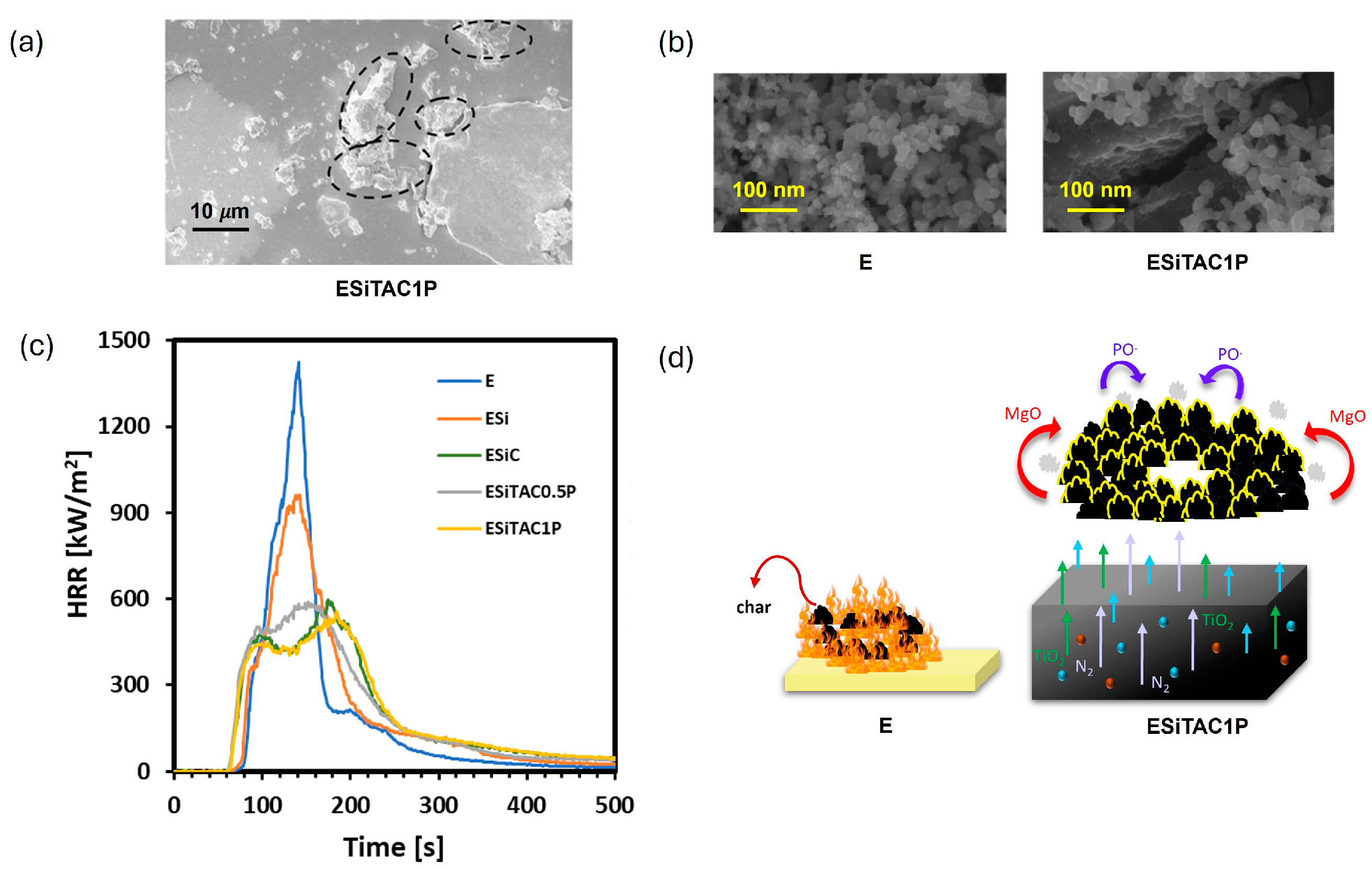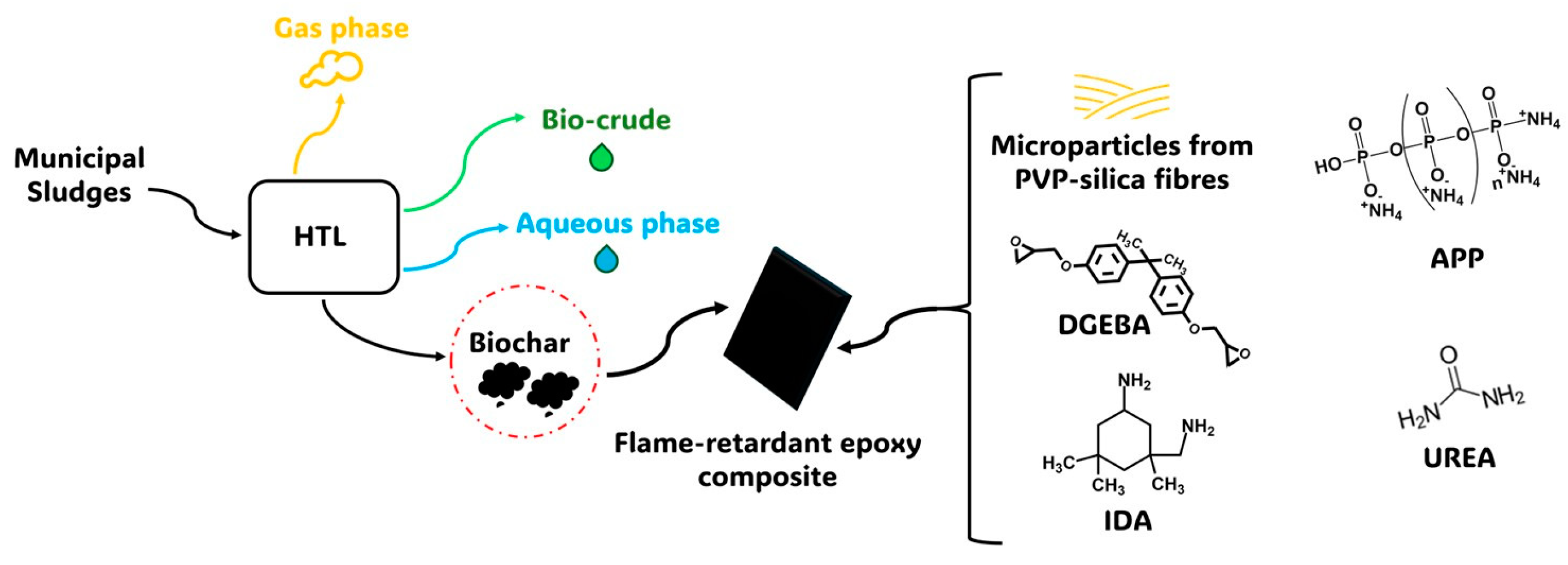Self-Extinguishing Epoxy Nanocomposites Containing Industrial Biowastes as Sustainable Flame-Retardant Additives †
Abstract
1. Introduction
2. Flame-Retardant Hybrid Silicon-Epoxy Resins Containing Humic Acid
3. Flame-Retardant Hybrid Silicon-Epoxy Resins Containing Coffee Biochar
4. Future Outlooks: Biochar Obtained from the Hydrothermal Liquefaction of Municipal Sludge
5. Conclusions
Author Contributions
Funding
Institutional Review Board Statement
Informed Consent Statement
Data Availability Statement
Acknowledgments
Conflicts of Interest
References
- Barra, G.; Guadagno, L.; Raimondo, M.; Santonicola, M.G.; Toto, E.; Vecchio Ciprioti, S. A Comprehensive Review on the Thermal Stability Assessment of Polymers and Composites for Aeronautics and Space Applications. Polymers 2023, 15, 3786. [Google Scholar] [CrossRef] [PubMed]
- Mong, G.R.; Tan, H.; Sheng, D.D.C.V.; Kek, H.Y.; Nyakuma, B.B.; Woon, K.S.; Othman, M.H.D.; Kang, H.S.; Goh, P.S.; Wong, K.Y. A Review on Plastic Waste Valorisation to Advanced Materials: Solutions and Technologies to Curb Plastic Waste Pollution. J. Clean. Prod. 2023, 434, 140180. [Google Scholar]
- Liu, B.; Zhao, H.; Wang, Y. Advanced Flame-retardant Methods for Polymeric Materials. Adv. Mater. 2022, 34, 2107905. [Google Scholar]
- Bragaglia, M.; Paleari, L.; Passaro, J.; Russo, P.; Fabbrocino, F.; Luciano, R.; Nanni, F. 3D Printing of Biodegradable and Self-Monitoring SWCNT-Loaded Biobased Resin. Compos. Sci. Technol. 2023, 243, 110253. [Google Scholar]
- He, W.; Song, P.; Yu, B.; Fang, Z.; Wang, H. Flame Retardant Polymeric Nanocomposites through the Combination of Nanomaterials and Conventional Flame Retardants. Prog. Mater. Sci. 2020, 114, 100687. [Google Scholar]
- Das, O.; Kim, N.K.; Hedenqvist, M.S.; Bhattacharyya, D.; Johansson, E.; Xu, Q.; Holder, S. Naturally-Occurring Bromophenol to Develop Fire Retardant Gluten Biopolymers. J. Clean. Prod. 2020, 243, 118552. [Google Scholar]
- Wang, Y.; Yuan, J.; Ma, L.; Yin, X.; Zhu, Z.; Song, P. Fabrication of Anti-Dripping and Flame-Retardant Polylactide Modified with Chitosan Derivative/Aluminum Hypophosphite. Carbohydr. Polym. 2022, 298, 120141. [Google Scholar] [PubMed]
- Wang, X.; Yang, G.; Guo, H. Tannic Acid as Biobased Flame Retardants: A Review. J. Anal. Appl. Pyrolysis 2023, 174, 106111. [Google Scholar]
- Bifulco, A.; Marotta, A.; Passaro, J.; Costantini, A.; Cerruti, P.; Gentile, G.; Ambrogi, V.; Malucelli, G.; Branda, F. Thermal and Fire Behavior of a Bio-Based Epoxy/Silica Hybrid Cured with Methyl Nadic Anhydride. Polymers 2020, 12, 1661. [Google Scholar] [CrossRef]
- Venezia, V.; Matta, S.; Lehner, S.; Vitiello, G.; Costantini, A.; Gaan, S.; Malucelli, G.; Branda, F.; Luciani, G.; Bifulco, A. Detailed Thermal, Fire, and Mechanical Study of Silicon-Modified Epoxy Resin Containing Humic Acid and Other Additives. ACS Appl. Polym. Mater. 2021, 3, 5969–5981. [Google Scholar]
- Ke, Y.; Yang, X.; Chen, Q.; Xue, J.; Song, Z.; Zhang, Y.; Madbouly, S.A.; Luo, Y.; Li, M.; Wang, Q. Recyclable and Fluorescent Epoxy Polymer Networks from Cardanol via Solvent-Free Epoxy-Thiol Chemistry. ACS Appl. Polym. Mater. 2021, 3, 3082–3092. [Google Scholar] [CrossRef]
- Lee, S.; Roh, Y.; Koh, D.-C. Oxidation and Reduction of Redox-Sensitive Elements in the Presence of Humic Substances in Subsurface Environments: A Review. Chemosphere 2019, 220, 86–97. [Google Scholar] [CrossRef]
- Liu, C.; Chen, T.; Yuan, C.H.; Song, C.F.; Chang, Y.; Chen, G.R.; Xu, Y.T.; Dai, L.Z. Modification of Epoxy Resin through the Self-Assembly of a Surfactant-like Multi-Element Flame Retardant. J. Mater. Chem. A 2016, 4, 3462–3470. [Google Scholar] [CrossRef]
- Forcina, A.; Petrillo, A.; Travaglioni, M.; di Chiara, S.; De Felice, F. A Comparative Life Cycle Assessment of Different Spent Coffee Ground Reuse Strategies and a Sensitivity Analysis for Verifying the Environmental Convenience Based on the Location of Sites. J. Clean. Prod. 2023, 385, 135727. [Google Scholar] [CrossRef]
- Giorcelli, M.; Bartoli, M. Development of Coffee Biochar Filler for the Production of Electrical Conductive Reinforced Plastic. Polymers 2019, 11, 1916. [Google Scholar] [CrossRef] [PubMed]
- Bifulco, A.; Bartoli, M.; Climaco, I.; Franchino, M.C.; Battegazzore, D.; Mensah, R.A.; Das, O.; Vahabi, H.; Malucelli, G.; Aronne, A. Coffee Waste-Derived Biochar as a Flame Retardant for Epoxy Nanocomposites. Sustain. Mater. Technol. 2024, 41, e01079. [Google Scholar] [CrossRef]
- Li, P.; Li, L.; Ji, L.; Dang, L.; Lan, S.; Zhu, D. Functionalized Magnesium Hydroxide with Zinc Borate and 3-aminopropyltriethoxysilane for Enhanced Flame Retardant and Smoke Suppressant Properties of Epoxy Resins. J. Appl. Polym. Sci. 2023, 140, e53941. [Google Scholar] [CrossRef]
- Bifulco, A.; Tescione, F.; Capasso, A.; Mazzei, P.; Piccolo, A.; Durante, M.; Lavorgna, M.; Malucelli, G.; Branda, F. Effects of Post Cure Treatment in the Glass Transformation Range on the Structure and Fire Behavior of in Situ Generated Silica/Epoxy Hybrids. J. Sol-Gel Sci. Technol. 2018, 87, 156–169. [Google Scholar] [CrossRef]
- Qiu, X.; Wan, X.; Wang, Z.; Li, Z.; Li, J.; Li, X.; Zhang, Z. A Simple and Universal Strategy for Construction and Application of Silica-Based Flame-Retardant Nanostructure. Compos. Part B Eng. 2022, 238, 109887. [Google Scholar] [CrossRef]
- Cheng, Z.; Fang, M.; Chen, X.; Zhang, Y.; Wang, Y.; Li, H.; Qian, J. Thermal Stability and Flame Retardancy of a Cured Trifunctional Epoxy Resin with the Synergistic Effects of Silicon/Titanium. ACS Omega 2020, 5, 4200–4212. [Google Scholar] [CrossRef]
- Camino, G.; Tartaglione, G.; Frache, A.; Manferti, C.; Costa, G. Thermal and Combustion Behaviour of Layered Silicate–Epoxy Nanocomposites. Polym. Degrad. Stab. 2005, 90, 354–362. [Google Scholar]
- Bifulco, A.; Casciello, A.; Imparato, C.; Forte, S.; Gaan, S.; Aronne, A.; Malucelli, G. A Machine Learning Tool for Future Prediction of Heat Release Capacity of In-Situ Flame Retardant Hybrid Mg (OH) 2-Epoxy Nanocomposites. Polym. Test. 2023, 127, 108175. [Google Scholar]
- Branda, F.; Passaro, J.; Pauer, R.; Gaan, S.; Bifulco, A. Solvent-Free One-Pot Synthesis of Epoxy Nanocomposites Containing Mg (OH) 2 Nanocrystal–Nanoparticle Formation Mechanism. Langmuir 2022, 38, 5795–5802. [Google Scholar] [CrossRef]
- Liu, H.; Basar, I.A.; Nzihou, A.; Eskicioglu, C. Hydrochar Derived from Municipal Sludge through Hydrothermal Processing: A Critical Review on Its Formation, Characterization, and Valorization. Water Res. 2021, 199, 117186. [Google Scholar]
- Parsa, M.; Jalilzadeh, H.; Pazoki, M.; Ghasemzadeh, R.; Abduli, M. Hydrothermal Liquefaction of Gracilaria Gracilis and Cladophora Glomerata Macro-Algae for Biocrude Production. Bioresour. Technol. 2018, 250, 26–34. [Google Scholar] [PubMed]
- Baxter, L.L.; Miles, T.R.; Miles, T.R., Jr.; Jenkins, B.M.; Milne, T.; Dayton, D.; Bryers, R.W.; Oden, L.L. The Behavior of Inorganic Material in Biomass-Fired Power Boilers: Field and Laboratory Experiences. Fuel Process. Technol. 1998, 54, 47–78. [Google Scholar]
- Ponnusamy, V.K.; Nagappan, S.; Bhosale, R.R.; Lay, C.-H.; Nguyen, D.D.; Pugazhendhi, A.; Chang, S.W.; Kumar, G. Review on Sustainable Production of Biochar through Hydrothermal Liquefaction: Physico-Chemical Properties and Applications. Bioresour. Technol. 2020, 310, 123414. [Google Scholar]
- Das, C.; Tamrakar, S.; Kiziltas, A.; Xie, X. Incorporation of Biochar to Improve Mechanical, Thermal and Electrical Properties of Polymer Composites. Polymers 2021, 13, 2663. [Google Scholar] [CrossRef] [PubMed]
- Giorcelli, M.; Savi, P.; Khan, A.; Tagliaferro, A. Analysis of Biochar with Different Pyrolysis Temperatures Used as Filler in Epoxy Resin Composites. Biomass Bioenergy 2019, 122, 466–471. [Google Scholar]
- Zhang, Q.; Cai, H.; Yang, K.; Yi, W. Effect of Biochar on Mechanical and Flame Retardant Properties of Wood–Plastic Composites. Results Phys. 2017, 7, 2391–2395. [Google Scholar]
- Barbalini, M.; Bartoli, M.; Tagliaferro, A.; Malucelli, G. Phytic Acid and Biochar: An Effective All Bio-Sourced Flame Retardant Formulation for Cotton Fabrics. Polymers 2020, 12, 811. [Google Scholar] [CrossRef] [PubMed]
- Di Lauro, F.; Balsamo, M.; Solimene, R.; Alfieri, M.L.; Manini, P.; Migliaccio, R.; Salatino, P.; Montagnaro, F. Characterization of Biocrude Produced by Hydrothermal Liquefaction of Municipal Sewage Sludge in a 500 ML Batch Reactor. Ind. Eng. Chem. Res. 2024, 63, 955–967. [Google Scholar] [CrossRef]



| Sample | E (wt.%) | HA (wt.%) | AP (wt.%) | UR (wt.%) | APP (wt.%) | P (wt.%) | Si (wt.%) | UL-94 |
|---|---|---|---|---|---|---|---|---|
| E | 79.4 | NC * | ||||||
| E12AP | 79.4 | 12 | 1.4 | NC * | ||||
| E6AP_6HAURAPP | 79.4 | 3 | 3 | 2 | 2 | 0.6 | 0.4 | NC * |
| E12AP_12HAURAPP | 79.4 | 6 | 6 | 4 | 4 | 1.1 | 0.6 | V-0 |
| Sample | E (wt.%) | CB (wt.%) | AP (wt.%) | Si-Ti-Mg (wt.%) | APP (wt.%) | P (wt.%) | UL-94 |
|---|---|---|---|---|---|---|---|
| E | 79.4 | - | - | - | - | - | NC * |
| ESi | 79.4 | - | 7 | - | - | - | NC * |
| ESiC | 79.4 | 20 | 7 | - | - | - | NC * |
| ESiTAC0.5P | 79.4 | 10 | 7 | 7 | 1.5 | 0.5 | V1 |
| ESiTAC1P | 79.4 | 20 | 7 | 14 | 3 | 1 | V-0 |
Disclaimer/Publisher’s Note: The statements, opinions and data contained in all publications are solely those of the individual author(s) and contributor(s) and not of MDPI and/or the editor(s). MDPI and/or the editor(s) disclaim responsibility for any injury to people or property resulting from any ideas, methods, instructions or products referred to in the content. |
© 2025 by the authors. Licensee MDPI, Basel, Switzerland. This article is an open access article distributed under the terms and conditions of the Creative Commons Attribution (CC BY) license (https://creativecommons.org/licenses/by/4.0/).
Share and Cite
Climaco, I.; Imparato, C.; Di Lauro, F.; Passaro, J.; Balsamo, M.; Russo, P.; Vahabi, H.; Malucelli, G.; Montagnaro, F.; Aronne, A.; et al. Self-Extinguishing Epoxy Nanocomposites Containing Industrial Biowastes as Sustainable Flame-Retardant Additives. Eng. Proc. 2025, 90, 79. https://doi.org/10.3390/engproc2025090079
Climaco I, Imparato C, Di Lauro F, Passaro J, Balsamo M, Russo P, Vahabi H, Malucelli G, Montagnaro F, Aronne A, et al. Self-Extinguishing Epoxy Nanocomposites Containing Industrial Biowastes as Sustainable Flame-Retardant Additives. Engineering Proceedings. 2025; 90(1):79. https://doi.org/10.3390/engproc2025090079
Chicago/Turabian StyleClimaco, Immacolata, Claudio Imparato, Francesca Di Lauro, Jessica Passaro, Marco Balsamo, Pietro Russo, Henri Vahabi, Giulio Malucelli, Fabio Montagnaro, Antonio Aronne, and et al. 2025. "Self-Extinguishing Epoxy Nanocomposites Containing Industrial Biowastes as Sustainable Flame-Retardant Additives" Engineering Proceedings 90, no. 1: 79. https://doi.org/10.3390/engproc2025090079
APA StyleClimaco, I., Imparato, C., Di Lauro, F., Passaro, J., Balsamo, M., Russo, P., Vahabi, H., Malucelli, G., Montagnaro, F., Aronne, A., & Bifulco, A. (2025). Self-Extinguishing Epoxy Nanocomposites Containing Industrial Biowastes as Sustainable Flame-Retardant Additives. Engineering Proceedings, 90(1), 79. https://doi.org/10.3390/engproc2025090079












